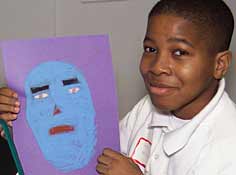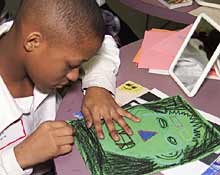
Lesson plan based on Cycladic Figure
Explore and compare abstraction of human forms in various ancient cultures and by creating self—portraits using geometric shapes.
Skills and Focus: Art Appreciation, Studio
Subject Area: Fine Arts
Thematic Connection: Connecting Past and Present
Grade Level: Middle School
Time Needed: 60 minutes
Objective
• Identify the Cycladic figure as an example of abstraction utilizing geometric shapes.
• Identify how the artist used geometric shapes to indicate the parts of the body on the figure.
• Compare and contrast the use of abstraction in the Cycladic figure to an abstracted image from another culture, such as the ancient Mexican Seated Male "Storyteller" Figure, or Barbara Hepworth's Two Figures (Menhirs).
• Use this knowledge of abstraction, form, and shape to create an abstract self-portrait.
Instructional Materials Needed
Stories: Who Is This? and The Human Form in Cycladic Art
Drawing paper
Pencils, pastels, oil crayons, and/or tempera paints

Activity
Step 1: Discuss how and why the Cycladic figure is an example of abstraction.
Critical Thinking Ask students to
• explain how you know this statue represents a human figure.
• describe the human features the artist included to communicate the figure’s humanity.
• identify which geometric shapes form the following features: face, nose, arms, torso, legs, feet.
Finally, have each student draw or label these shapes on the Cycladic figure template.
Step 2: Have students compare the Cycladic figure to the abstraction of the ancient Mexican sculpture or Hepworth's Two Figures.
Critical Thinking Ask students to
• identify those features the other artists have emphasized.
• explain whether these other artists have used the same shapes seen in the Cycladic figure or different shapes.
• describe how the materials used to create the pieces differ?
• explain what these materials enable the artists to do differently.
Step 3: Instruct students to create their own abstract self-portraits (including hair styles, clothing, jewelry, and so on) using paper and the medium of their choice. Remind students to use geometric shapes as much as possible. Display the self—portraits in class.
Goals
This activity meets Illinois State Goal 25: Know the language of the arts.
This activity meets Illinois State Goal 26: Through creating and performing, understand how works of art are produced.
© 2000, by The Art Institute of Chicago. All rights reserved. Use of this program is subject to the terms below. No part of this program may be reproduced, transmitted or distributed in any form or by any means, except for personal or classroom use. All Copyright in and to the program, in whole or in part, belongs to the publisher and its licensors and is registered with the U.S. Copyright Office